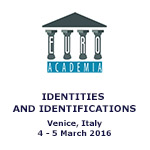Euroacademia Conferences
 Europe Inside-Out: Europe and Europeanness Exposed to Plural Observers (9th Edition) April 24 - 25, 2020
Europe Inside-Out: Europe and Europeanness Exposed to Plural Observers (9th Edition) April 24 - 25, 2020 Identities and Identifications: Politicized Uses of Collective Identities (9th Edition) June 12 - 13, 2020
Identities and Identifications: Politicized Uses of Collective Identities (9th Edition) June 12 - 13, 2020 8th Forum of Critical Studies: Asking Big Questions Again January 24 - 25, 2020
8th Forum of Critical Studies: Asking Big Questions Again January 24 - 25, 2020 Re-Inventing Eastern Europe (7th Edition) December 13 - 14, 2019
Re-Inventing Eastern Europe (7th Edition) December 13 - 14, 2019 The European Union and the Politicization of Europe (8th Edition) October 25 - 26, 2019
The European Union and the Politicization of Europe (8th Edition) October 25 - 26, 2019 Identities and Identifications: Politicized Uses of Collective Identities (8th Edition) June 28 - 29, 2019
Identities and Identifications: Politicized Uses of Collective Identities (8th Edition) June 28 - 29, 2019 The European Union and the Politicization of Europe (7th Edition) January 25 - 26, 2019
The European Union and the Politicization of Europe (7th Edition) January 25 - 26, 2019 7th Forum of Critical Studies: Asking Big Questions Again November 23 - 24, 2018
7th Forum of Critical Studies: Asking Big Questions Again November 23 - 24, 2018 Europe Inside-Out: Europe and Europeanness Exposed to Plural Observers (8th Edition) September 28 - 30, 2018
Europe Inside-Out: Europe and Europeanness Exposed to Plural Observers (8th Edition) September 28 - 30, 2018 Identities and Identifications: Politicized Uses of Collective Identities (7th Edition) June 14 - 15, 2018
Identities and Identifications: Politicized Uses of Collective Identities (7th Edition) June 14 - 15, 2018
Embattled Towns – Images of the Balkans in Descriptions and Travelogues of the 17th and Beginning 18th Centuries
-
-

-
Presentation speakers
- Elke Katharina Wittich, Hochschule Fresenius, Hamburg, Germany
- Download presentation
Abstract:
The Balkans have been part of different dominions with orientations towards various religions from the 16th to 18th centuries. Some of them, like Ragusa, were independent city-states for a long time. Another like Dalmatia sometimes were part of Venice, at another time of Hungary and later on of the Habsburg state. Others as Bosnia partly belonged to the Ottoman Empire. But all of them have one very fundamental property in common: they were located at the travel routes from Vienna to Constantinople, and were therefore addressed in travelogues as well as in reports on topographical and geographical, historical and political issues. In the late 17th century the number of these reports rapidly increased because of the Ottoman Wars. They contain a remarkable amount of maps and illustrations, which can be used to explore the means of visualization in regard to urban image construction. These images were presented as a sequence of recurring visual icons such as elevations of most admirable buildings, or the constantly imparted views of embattled towns. In spite of all these towns in the Balkans giving evidence of a long-range and quite valuable intercultural exchange in architecture and all other fields of cultural, economic, political and religious communications, the direction of mobility through the Balkans was of such importance for Northern European nations that one of them – moving southwards – was seen in the context of knowledge acquisition and commercial relations, the other one – going northwards – was put on a level with hazard and destruction. In regard to images of towns in the Balkans in the late 17th and beginning 18th centuries, the Thesaurus Exoticorum by Eberhard Werner Happel as an example of reporting actual incidents provides access not only to the different forms of visualizations, but to interactions of pictorial genres in text illustrations and to interactions of pictorial material and texts in different genres of literature and medias as well.
-
Related Presentations

Shifting Focus
- Nicholas Chilvers













